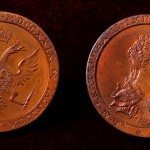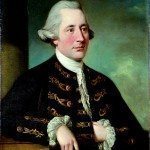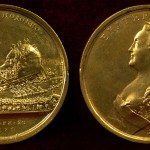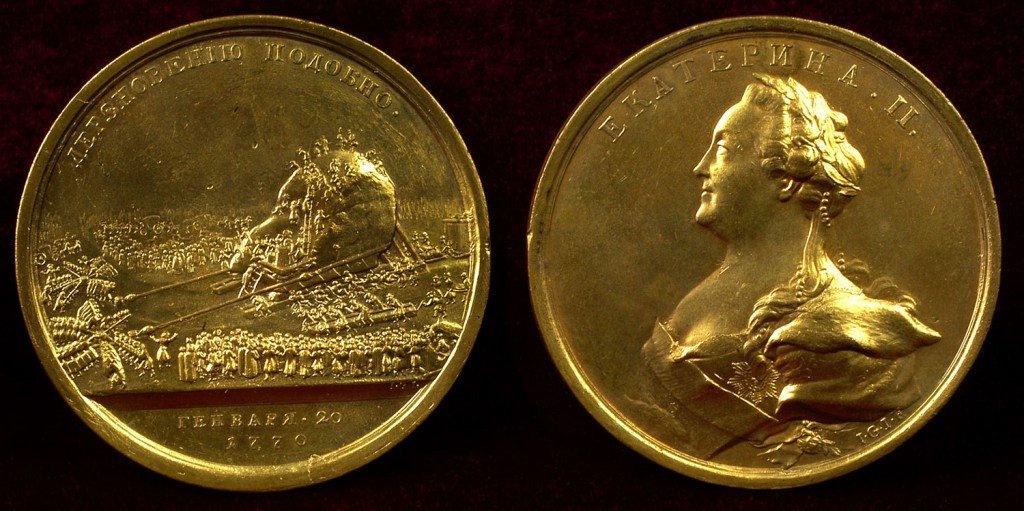Interpretations
Image: Russian Medallion to commemorate the erection of Peter the Great’s statue in 1773. The medal was struck during the Reign of Catherine the Great and shows a bust of the Empress.
Image from: Birmingham Assay Office (605)
The letter from Matthew Boulton to James Watt does not seem to have been published in its entirety. Samuel Smiles appears to be the first historian who saw the original. He did not publish it, but in his book Lives of Boulton and Watt (1865) he quoted this particular sentence in the following context: “Among other things he [Boulton] informed Watt that he had put his little boy Jamie to a good school, and that he was very much occupied, as usual, in entertaining visitors. “The Empress of Russia”, he wrote, “is now at my house and a charming woman she is” (p.216).
Seventy years later, in 1936, H W Dickinson repeated this information in the book Matthew Boulton: “He even had the Empress Catherine herself in 1776”. Since then several generations of scholars from various fields of academic research have picked up the phrase from Smiles’ or Dickinson’s books in order to support their own speculations. We find it in the article “Matthew Boulton and Conrad Heinrich Kuchler” by J G Pollard (The Numismatic Chronicle, Vol.X, London. 1970); on the recent website www.jquarter.members.beeb.net which introduces the history of Birmingham; in the E. Robinson’s article “Birmingham Capitalists and Russian Workers”; in the second edition of H W Dickinson’s book (1999); and even in as authoritative publication, as The Industrial Revolution. A Documentary History, Series One, Part 1 (Andrew Matthew Publications, 1993).
At the present time Catherine the Great’s visit to Soho seems almost common knowledge and an established fact of local history.
One of the particular features of Catherine’s II reign was that she never travelled abroad. During the 34 years of her reign, she undertook only the journeys between St Petersburg and Moscow, or to the environs of Moscow for obligatory Orthodox pilgrimages. The only really long journey that she made was in 1787, to the South of Russia, in order to see her recently annexed territories, especially the Crimea.
She had serious reasons not to leave the country. As a German princess succeeding to the throne after the murder in 1762 of her husband Peter III, who was the legitimate descendant of Peter the Great, she had to be very cautious in order to keep her own position safe. The situation was particularly dangerous for her at the time of her supposed journey to England. A short time before, a two year long peasant war led by E.Pugachev had shaken the state. It is significant that Pugachev declared himself the Emperor Peter III, who had not been murdered but now appeared to fight against “the German, the Devil’s daughter”. And he was not the first, but the third pretender to take the name of Peter III. With great difficulty the revolt had been suppressed, and the leader of the rebellious Cossacks was beheaded in Moscow on 10th of January 1775.
At the time of the Pugachev’s revolt, the so-called Princess Tarakanova who had proclaimed herself a daughter of the Empress Elizabeth, appeared in Europe. She was kidnapped by Alexei Orlov, in June 1775 brought to Petersburg, and died in the Peter-Paul-Fortress in December 1775. It is obvious, that this series of pretenders was a real threat to Catherine II, so it would have been a most inappropriate time for her to leave the country.
Furthermore, a number of contemporaries were present at the Russian Court at the time of her supposed visit to England. A French envoy, Chevalier de Corberon, kept a diary of his life at Court. Gossiping about Catherine’s love affairs, and her relations with G Potemkin and P Zavadovskii, de Corberon at the same time testified to the Empress’ presence in Moscow, and then in Petersburg in January-March 1776, the time of her alleged journey abroad .
The date of M Boulton’s letter should also have alerted local historians. The usual way from Russia to England was by sea, but it was impossible to undertake this journey in January-February, as navigation had to stop for the winter months because the Finnish Gulf was frozen.
By 1776 Catherine II was one of the strongest and most influential European monarchs. Shortly before Sir Robert Gunning had approached her for military assistance in the American War . She refused, but anyway, her visit to England would have been an event of particularly great importance for British politics. It is unbelievable that it was not mentioned in any Russian or British documents except Matthew Boulton’s letter.
All these facts are very well known to scholars involved in historical research. Such a mistake could not have been made by authors undertaking Russian and Slavonic Studies.
The scholars who have quoted the sentence did not see the whole text of Boulton’s letter. It would have been obvious, that he simply made a little joke, and had mentioned not a visit of Empress Catherine the Great to his house, but the receipt of some image of her, presumably a portrait, on which she looked “a charming woman”. In 1772 Boulton had sent a huge amount of ormolu wares to Catherine the Great, and she repeated the orders in 1774, and then in 1776, although at the same time she did not buy his sidereal clock . However, a portrait, or perhaps a snuffbox with a portrait (a usual present from Russian Emperors in the 18th century) might have been a sign of her appreciation.
It is pity to destroy a nice Birmingham legend, but even local studies must be based on historical truth. This truth however opens the way for looking for the image of Catherine the Great – an artefact, which could become a fine addition to the commemorative museum in Matthew Boulton’s Soho House.
« Previous in this section
Continue browsing this section
 Catherine the Great and her non-visit to Soho House
Catherine the Great and her non-visit to Soho House
 The Evidence
The Evidence
 Interpretations
Interpretations






